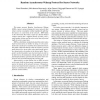Free Online Productivity Tools
i2Speak
i2Symbol
i2OCR
iTex2Img
iWeb2Print
iWeb2Shot
i2Type
iPdf2Split
iPdf2Merge
i2Bopomofo
i2Arabic
i2Style
i2Image
i2PDF
iLatex2Rtf
Sci2ools
BROADNETS
2004
IEEE
2004
IEEE
Random Asynchronous Wakeup Protocol for Sensor Networks
This paper presents Random Asynchronous Wakeup (RAW), a power saving technique for sensor networks that reduces energy consumption without significantly affecting the latency or connectivity of the network. RAW builds on the observation that when a region of a shared-channel wireless network has a sufficient density of nodes, only a small number of them need be active at any time to forward traffic for active connections. RAW is a distributed, randomized algorithm where nodes make local decisions on whether to sleep, or to be active. Each node is awake for a randomly chosen fixed interval per time frame. High node density results in existence of several paths between two given nodes whose path length and delay characteristics are similar to the shortest path. Thus, a packet can be forwarded to any of several nodes in order to be delivered to the destination without affecting much the path length and delay experienced by the packet when compared to when forwarded through the shortest p...
Related Content
| Added | 20 Aug 2010 |
| Updated | 20 Aug 2010 |
| Type | Conference |
| Year | 2004 |
| Where | BROADNETS |
| Authors | Vamsi Paruchuri, Shivakumar Basavaraju, Arjan Durresi, Rajgopal Kannan, S. Sitharama Iyengar |
Comments (0)

